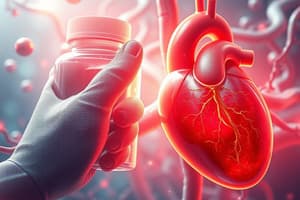Podcast
Questions and Answers
What are inotropic drugs and what effect do they have on the heart?
What are inotropic drugs and what effect do they have on the heart?
Inotropic drugs are medications that induce vasoconstriction or increase cardiac contractility, leading to a stronger force of contraction in the heart muscle.
List the classes of antiarrhythmic drugs and provide an example for each class.
List the classes of antiarrhythmic drugs and provide an example for each class.
Class I: Sodium channel blockers (e.g., quinidine), Class II: Beta adrenergic blockers (e.g., propranolol), Class III: Potassium channel blockers (e.g., amiodarone), Class IV: Calcium channel blockers (e.g., verapamil), Class V: Cardiac glycosides (e.g., digoxin).
What causes angina pectoris and what is its underlying mechanism?
What causes angina pectoris and what is its underlying mechanism?
Angina pectoris is caused by an imbalance between oxygen supply and demand in the myocardium, with metabolites accumulating due to myocardial ischemia leading to pain.
Name two categories of drugs used to treat angina pectoris and provide an example from each.
Name two categories of drugs used to treat angina pectoris and provide an example from each.
What is the primary physiological effect of positive inotropic drugs?
What is the primary physiological effect of positive inotropic drugs?
Flashcards are hidden until you start studying
Study Notes
Inotropic Drugs
- Inotropic medications are used to either induce vasoconstriction or increase the strength of heart contractions.
- Positive inotropes increase the force of contraction of the heart muscle.
- Examples of positive inotropic drugs include:
- Cardiac glycosides (digoxin and digitoxin)
- Bipyridine derivatives (amrinone)
- Sympathomimetics (dobutamine, dopamine)
- Methylxanthines (theophylline)
Antiarrhythmic Drugs
- Antiarrhythmic drugs prevent or treat irregular heart rhythms.
- These drugs are categorized into five classes based on their mechanism of action:
- Class I: Sodium Channel Blockers (quinidine, lidocaine)
- Class II: Beta Adrenergic Blockers (propranolol, atenolol)
- Class III: Potassium Channel Blockers (amiodarone)
- Class IV: Calcium Channel Blockers (verapamil)
- Class V: Cardiac Glycosides (digoxin)
Angina Pectoris
- Angina Pectoris is characterized by chest pain caused by an imbalance between the heart's oxygen supply and demand.
- The pain in angina pectoris is caused by the accumulation of metabolites due to myocardial ischemia.
Angina Pectoris Medications
- Treatments for angina pectoris include:
- Organic nitrates (nitroglycerine, isosorbide dinitrate)
- Beta adrenergic blocking agents (propranolol, atenolol)
- Calcium channel blocking agents (verapamil, nifedipine)
- Miscellaneous drugs including aspirin and heparin
Hypertension
- Hypertension is defined as high blood pressure levels that exceed normal values.
- The choice of treatment for hypertension depends on a variety of factors including the patient's age, sex, race, body build, lifestyle, and any other diseases they may have.
Non-Pharmacological Therapy for Hypertension
- Non-pharmacological therapy for hypertension includes:
- Low sodium chloride and saturated fat diet
- Weight reduction
- Exercise
- Smoking and alcohol cessation
- Psychological methods such as relaxation
Pharmacological Therapy for Hypertension
- Pharmacological therapy for hypertension includes:
- Diuretics (Hydrochlorothiazide, Furosemide)
- Beta Blockers (Atenolol, Metoprolol)
- Calcium Channel Blockers (Amlodipine, Diltiazem)
- ACE Inhibitors (Lisinopril, Enalapril)
- Angiotensin II Receptor Blockers (ARBs) (Losartan, Valsartan)
Studying That Suits You
Use AI to generate personalized quizzes and flashcards to suit your learning preferences.




